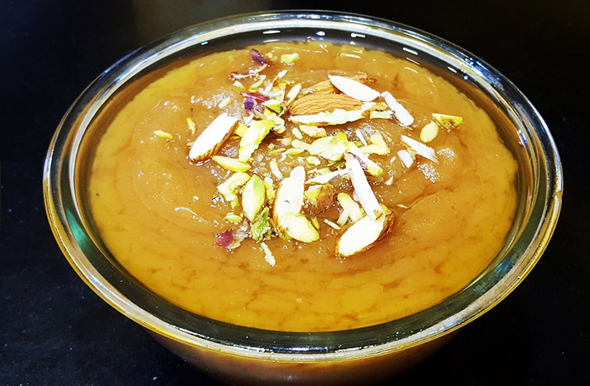Mama’s Punjabi Recipes: Dhuli Moong Di Daal De Aate Da Halwa (Yellow Moong Daal Flour Halwa)
Saved under Community, Current Stories, Recipe Corner
Tags: Baytown, Clear Lake, Cypress, Desi news, Dhuli Moong Di Daal De Aate Da Halwa, Greater Houston, Houston, Houston Desi news, India, Indian American community, Indian News, Indians in America, Indo-American News, Katy, Mama’s Punjabi Recipes, NRI, pearland, south asia, South India, Sugar Land, Texas, USA
Along the foothills of the Himalayas, all the way from the Northwest Frontier with Afghanistan down to the plains of the Punjab and across northern part of Uttar Pradesh, during the cold months, people seek out foods that not only keep them warm, but satisfy the taste buds. The bazaars and markets are full of sweets and confections, but in the Punjab, moong di daal da halwa (yellow moong lentil pudding) is an affordable dessert, eaten sometimes, that is found everywhere since it is high in calories and is keeps the body warm.
It was a cold December in 1945 when I was married in Lyallpur, West Punjab when I was just 18 years-old, and our family halwai (sweet maker) Lal Chand made what was then a new item – moong di daal da halwa – instead of the customary suji halwa (semolina pudding). There was lots left over, so he kept it and made pinnis (sweet balls) out of it and the family ate them through the rest of the winter! Nowadays, moong di daal da halwa is severed at auspicious occasions like Holi and Diwali and is considered chic to serve at weddings.
The halwa is usually made with split, dhuli peeli moong daal (skinless yellow moong lentils), and it takes a lot of patience to sauté and prepare the daal. There are three ways to make it: the original way, the faster way and the short cut, all dealing with the preparation.
In the original way, you must soak the daal for four or five hours, then place it in a grinder to make a coarse paste and then sauté it in ghee (clarified butter). The faster way is to boil the daal in just the right amount of water to let it become tender; drain the water through a sieve, sauté and then add the same water back. I have already given the recipe for these two ways.
This recipe is for the shortcut method which is to use moong daal flour which is easily available now and prepare like suji halwa by sautéing. The taste is not the same as the other two methods and I think the boiling method is the best.
Ingredients:
• 1 cup dhuli moong daal atta (split, skinless yellow daal flour)
• 3 cups tanda pani (cold water)
• 1 cup tael (olive oil; some may prefer ghee or clarified butter)
• 1 cup chinni (sugar)
• 1 tsp pissi illachi (cardamom powder)
• Mewa (dried fruits) to taste: dhule badam (blanched sliced almonds), piste (pistachios), kishmish (raisins), kharod (walnuts)
Directions:
1. Place the sugar in 3 cups of cold water in a small saucepan, let it come to a boil and then set aside. If you prefer a sweeter dish, then add ¼ cup more sugar.
2. Warm the oil in a medium sized kadai (wok) over medium heat, pour in the moong atta and stir till it becomes slightly brown.
3. Drop in the dried fruits and stir in for a few minutes.
4. When you see traces of oil come to the sides of the kadai, then add the chasni (syrup water) and stir continuously till the water begins to dry up. The halwa should not be runny, it is better served thick. It will also thicken when it cools down.
5. Turn the heat to low and when you see oil rise to the sides, then turn off the heat.
6. Sprinkle the cardamom on the top of the halwa before serving slightly warm.
MAMA’S TIP OF THE WEEK: HOW TO STORE ATTA (WHEAT FLOUR) DOUGH IN THE FRIDGE
Judging from the number of brands and the amount of bags of atta (wheat flour) that is sold in Indian grocery stores, it would be safe to say that there are still many people making fresh rotis (bread) in the house to go with every meal. Even though there is also a growing number of people who prefer to buy frozen rotis and paranthas (stuffed breads) from brands like Deep, Ashoka and Haldiram, there are many more who make their own bread at home.
For those people, making the dough is often the hardest part and so many of them make more than they need and store the rest for the next meal or day, usually in a container or a bowl. But these sometimes dry out in the fridge and the top surface becomes crusty. To avoid this, it is best to place the atta in an airtight container and coat the top with a little dab of vegetable oil to prevent the top from drying out.

Shakuntla Malhotra is a skilled cook of Punjabi dishes made in the old-fashioned style that she learnt as a young woman in her ancestral home in Lyallpur, India (since renamed Faisalabad) before it became part of Pakistan after the Partition in 1947. People have often admired her cooking for its simplicity and taste that comes with each mouthful. Even in her late-eighties, she continues to cook daily and agreed to share her delectable Punjabi vegetarian recipes for future generations.

